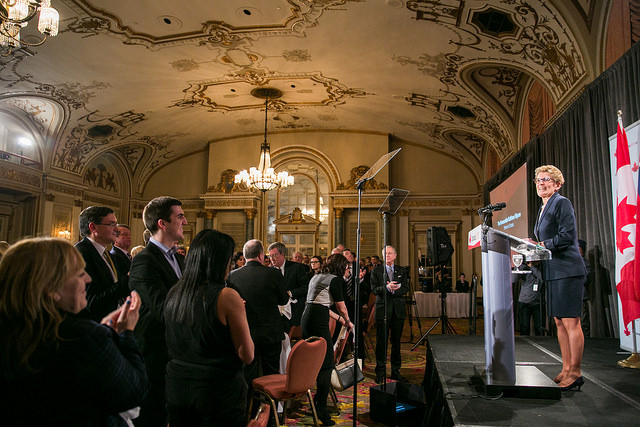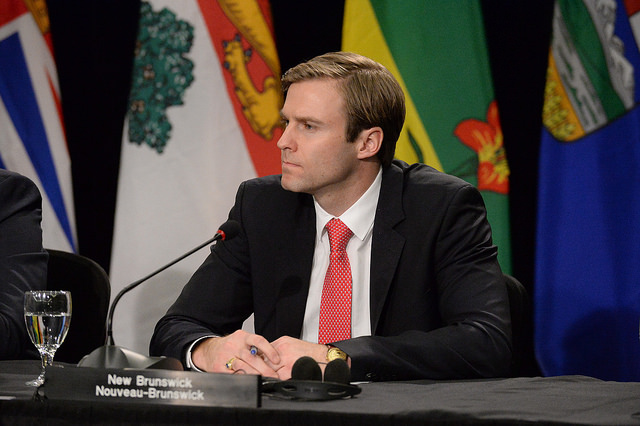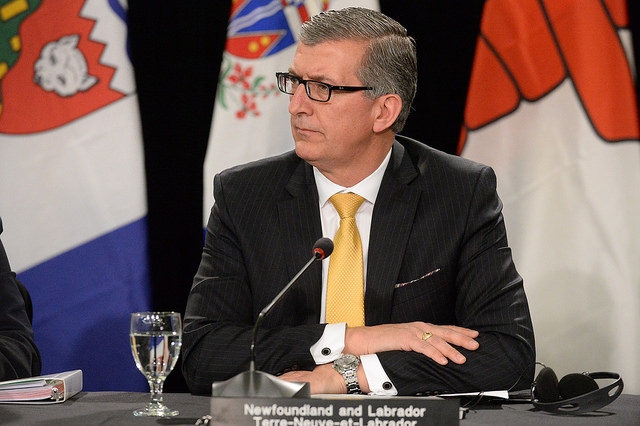
B.C. has a new policy for staking mining claims. Why doesn’t anyone like it?
B.C. previously allowed mineral claims without First Nations consultation. It was court-ordered to fulfill its...
In the lead up to December’s UN climate talks in Paris, most countries are approaching their promised emission reductions with new national regulations. Canada’s Conservative government is taking a different path.
Instead of considering a federal carbon tax, Environment Minister Leona Aglukkaq has asked premiers to submit their own cuts and how they will achieve them. In a letter submitted to all premiers on Friday afternoon, Minister Aglukkaq notes that Canada is falling far short of its promised 2020 emission cuts and suggests it is up to individual provinces to fill in the gaps.
Those reductions — plus working out the details of the Canadian Energy Strategy — form the agenda for Tuesday’s Premiers' Climate Summit on Climate in Quebec City.
On Saturday afternoon, more than 25,000 people filled the streets of Quebec City asking provincial leaders to take the action the federal government seems obstinately set against. And these marchers are not outliers: a new poll commissioned by Canada’s Climate Action Network revealed 70 per cent of Canadians want the country to become global leaders in protecting the climate.
That’s why this Premiers' Climate Summit is so important — it is their leadership (or not) that could make the difference in Canada finally taking climate action. But who are the premiers leading the way and who could hold back progress yet again? Read on.
Much has been written about British Columbia’s progressive and award-winning carbon tax. Since its inception in 2008, B.C. has reduced its annual CO2 emissions by 2.2 gigatonnes, taking strides towards its goal of a 33 per cent reduction from 2005 levels by 2020. Christy Clark, in the lead up to the summit, challenged other governments to 'meet or beat' the province's carbon tax.
Unfortunately, Clark promised to freeze the carbon tax for five years as part of her 2013 election campaign. At the same time, Clark also pledged to reinvigorate B.C.’s economy by developing a $100 billion industry around the export of liquefied natural gas to Asian markets. Neither of these actions are likely to help B.C. meet or exceed its emission reduction targets.
On the plus side, Clark is lukewarm on two proposed pipeline and tanker projects that would carry diluted bitumen from the Alberta oilsands to the B.C. coast. She has pledged to deny provincial operating permits to both Northern Gateway and Kinder Morgan’s TransMountain expansion unless they meet five conditions ranging from safety to profit sharing. After the dismal response to this week’s relatively small spill of toxic bunker fuel in Vancouver’s English Bay, the most important condition — a ‘world class’ oil spill response plan — seems unlikely to be met anytime soon.
Premier Clark will not attend the summit and will be speaking at a World Bank event instead.
Alberta is the source of the lion’s share of Canada’s emissions, thanks largely to the Athabasca oilsands. After more than a decade of high global oil prices fueled rapid growth in the industry, the market for oil futures (with the high prices that kept the oilsands profitable) collapsed last fall.
The expansion of Alberta’s oilsands infrastructure is the source of much discussion and contention. Premiers of B.C., Quebec and Ontario have all set conditions before allowing any of the three large pending oil pipeline and tanker projects to proceed through their provinces, and the Obama administration in the U.S. has said it will not allow the Keystone XL pipeline to proceed if it contributes to climate change.
In 2007, the Alberta government implemented a small carbon levy of $15/tonne for large emitters. The tax will expire on June 30, 2015.
Premier Jim Prentice (a former Federal Minister of Environment in the Harper Conservative cabinet) has said he supports the idea of “the provinces [finding] common ground on energy and the environment, and [enforcing] fair, clear, well thought-out rules,” but has yet to reveal any plans.
Premier Prentice is currently running for re-election. His office confirmed he will not attend Tuesday’s summit.
Since becoming Premier in 2007, Brad Wall has said or done little about climate change. He actively supports development of pipeline infrastructure, particularly TransCanada’s Energy East and Keystone XL pipelines. In 2014, he travelled to Washington, D.C., to lobby for the approval of the latter.
In a March 2014 roundtable interview with Canadian journalists he floated the idea of a moderate carbon tax as a being a means of encouraging the U.S. government to approve the pipeline. "I think you start slow and see what impact it has on the economy… I don't think you want to kneecap your economy with a carbon tax."
A few months later in November 2014, he approached the idea of CO2 emissions with a more fatalistic view, saying “If you want to get serious about (reducing) GHGs in Canada, we’d all stop driving cars.”
Premier Wall will not attend the summit.
Since taking office in 2009, Premier Greg Selinger has been outspoken on climate change and Manitoba’s need to adapt and take action. His administration held knowledge-sharing sessions with experts in neighbouring Wisconsin; he’s spoken at sustainability conferences in India and committed to a robust set of climate adaptation goals, including reducing greenhouse gas emissions to six per cent below 1990 levels, to about 17.5 megatonnes.
That said, after five years his administration has yet to table any large-scale legislation or programs to make these reductions a reality. A planned cap-and-trade program expected for implementation in 2012 has not materialized. In the meantime, climate change impacts continue to add up. As Scott Forbes wrote in a Winnipeg Free Press op-ed last summer:
“Even the most powerful politicians cannot hold back the rain. But they can plan for a rainy day. With higher spring and summer river levels now the new normal, lowering river levels is going to be harder than ever. So build the walkway higher. Rack up the cost to our changing climate.”
At present it is unclear if Premier Selinger will attend Tuesday’s summit.

Ontario is the second-largest source of GHG emissions in Canada, and has, in recent years, taken its reduction very seriously. Before leaving office in 2012, Premier Dalton McGuinty passed the Green Energy Act, and pushed forward legislation to end urban sprawl, protect clean drinking water and limit toxic chemicals in manufacturing.
Premier Kathleen Wynne seems poised to take things even further. Her administration has already made Ontario completely free of coal-fired power and pledged seven conditions before new pipeline infrastructure projects such as Energy East will be allowed to go forward.
Together with Quebec Premier Philippe Couillard, she has led the development of the Canadian Energy Strategy — the framework for the Premier’s Climate Summit.
On Monday, Premier Wynne signed a cap-and-trade agreement with Quebec Premier Couillard in advance of Tuesday’s climate summit.
Couillard is a climate action champion in his own right. He has worked closely with Ontario Premier Wynne on developing the Canadian Energy Strategy and his administration implemented a cap-and-trade scheme in partnership with California starting in January of this year. He opposes the Energy East pipeline plan for a terminal in Quebec (which fortunately for Quebeckers and belugas, has been dropped in TransCanada’s latest plans) and as of December 2014, supports continuing a moratorium on hydraulic fracturing in the province saying "if there’s no segment of the population that approves of the practice, then I don’t see the interest in developing it."
He’s also repeatedly said that he hopes for Quebec to have an important voice at December’s UN Climate Summit in Paris.
“I will ensure that Quebec is not only present, but also that it has the opportunity to make its voice heard.”

Premier Brian Gallant’s leadership on climate and energy is inconsistent. Despite imposing a moratorium on fracking across the province, he is an active and vocal supporter of the Energy East pipeline. This proposed pipeline would carry diluted bitumen from the Alberta oilsands to a deepwater port on the Bay of Fundy for export to international markets.
Speaking at January news conference, Gallant said:
"There's no doubt as a nation we have to do a better job on climate change…On top of that, we also have to have a conversation about developing our economy throughout the country in a responsible way. We believe the Energy East pipeline is one that will help us grow our economy, create jobs; it's one we that we can do, we believe, in a sustainable way."
Premier Gallant will attend the summit.
After implementing a law in 2010 that required the province to meet 25 per cent of its energy needs from renewable sources, the province is now on track for a second goal: generating 40 per cent of its electricity by 2020.
In fall 2014, the province also imposed a moratorium on onshore fracking, except for research or testing purposes.
Speaking to delegates at a conference, Premier McNeil said, "Nova Scotia is a small province with a big future in sustainable energy. We're addressing climate change and the need for a lower carbon future by embracing change through innovation that focuses on one of our greatest advantages — our proximity to the ocean and its tides."
Premier McNeil will not attend the summit; he's sending Environment Minister Randy Delorey instead.
Wade McLauchlan took the Premier’s oath of office less than 50 days ago. In his speech accepting the title of premier designate, Mclauchlan called P.E.I. a world leader in renewable energy, but said we can do more as “an important first step as we turn our attention to climate change.”
At press time, it is unclear whether Premier MacLauchlan will attend Tuesday’s summit.

Elected premier by a narrow margin in fall 2014, Paul Davis won his seat by pledging to protect the province’s offshore oil and gas extraction industry and ensure the billions of dollars it generates in royalties are better shared around the province.
On Friday April 10, Premier Davis announced his plan to attend the climate summit, citing an opportunity “to discuss best practices and future solutions in the fight against climate change and strengthen intergovernmental cooperation.”
Despite promising to do so back in 2009, the Yukon has yet to set targets for territory-wide emission reductions.
In 2012, Premier Darrell Pasloski’s government announced that it would be impossible to predict future industrial and economic growth, and recommended the following action instead: “Rather than commit to an arbitrary target based on estimated projections of Yukon’s economic growth, the government is working with key players in the electricity, building and energy efficiency, industrial, and transportation sectors to identify actions that will lead to realistic and measurable outcomes to minimize growth in Yukon’s overall GHG emissions.”
Instead, the government has committed to a reduction in emissions for its own internal operations — 20 per cent lower than 2010 levels by 2015.
Pasloski does not support mandatory carbon pricing and just last week announced plans to explore fracking in the territory’s Liard basin, provided it had the support of First Nations in the region.
Premier Pasloski will attend the summit.
Belying their huge size, both the Northwest Territories and Nunavut release approximately the same amount of GHG emissions as tiny Prince Edward Island. Despite this, their residents are disproportionately affected by rising seas and melting permafrost compared to Canadians in other provinces.
In 2014, the Premiers of the Northwest Territories and Nunavut met in Iqaluit to develop a strategy document for northern Canada, entitled ‘A Northern Vision.’ In it they agree that “clean, reliable, affordable energy is the backbone of a sustainable economy, is essential for the well-being of northerners, and fosters investment and economic growth in the North.”
At present it is not clear if either Premier McLeod or Premier Taptuna will attend the summit.
Image Credit: All images via Canada's Premiers
Get the inside scoop on The Narwhal’s environment and climate reporting by signing up for our free newsletter. On March 17, federal Conservative Leader Pierre Poilievre...
Continue reading
B.C. previously allowed mineral claims without First Nations consultation. It was court-ordered to fulfill its...

British Columbia has vowed to fast-track several mining projects in an effort to blunt the...

Alberta introduced North America’s first industrial carbon tax in 2007. Now an industry email obtained...
